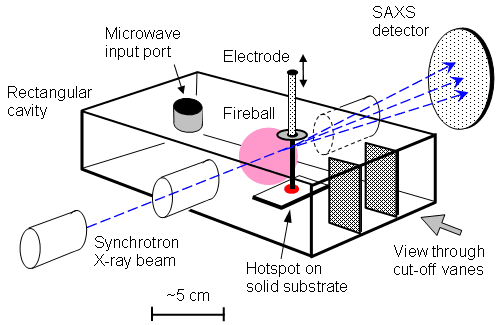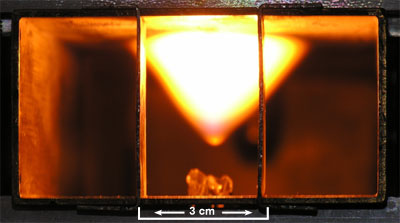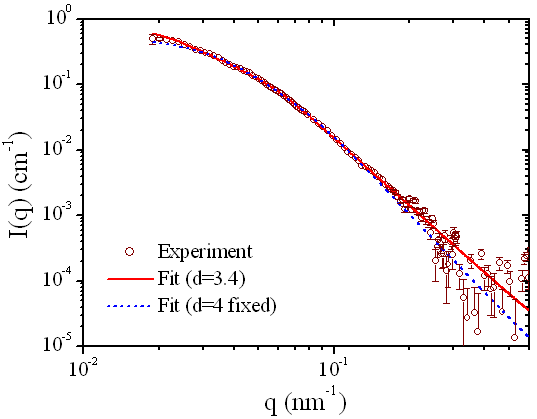- Home
- News
- Spotlight on Science
- Nanoparticles in...
Nanoparticles in ball-lightning-like fireballs
29-03-2008
The enigma of the natural ball-lightning phenomenon, reported by eyewitnesses as glowing luminescent objects floating in the air on rare occasions, has attracted scientists for more than a century. A model proposed by Abrahamson and Dinniss [1], explains the formation of ball-lightning as normal lightning that strikes the ground and ejects a plume of Si, SiO and SiC nanoparticles whose oxidation sustains the glow of ball-lightning.
Share
We used a microwave fireball generator developed by Dikhtyar and Jerby [2] to mimic the atmospheric ball-lightning and to investigate the internal structure by small-angle X-ray scattering (SAXS) at the ESRF beamline ID02. If particles were present, SAXS would provide quantitative information about the particle size, morphology, size distribution, number density, and eventually the decay rate when the microwave source is turned off.
 |
|
|
Figure 1: Schematic view of the experimental setup used for in situ investigation of the fireball. |
The experimental setup shown in Figure 1 consists of a microwave cavity in which the energy is concentrated by a movable electrode into the substrate material. This forms a molten hot-spot on the surface, from which the fireball evolves. Figure 2 shows an optical image of such a fireball created from a substrate of borosilicate glass. The fireball may last for several minutes, as long as it is irradiated by the microwave power, but it tends to quiver so that the positional stability is limited to a few seconds. The X-ray beam crosses the fireball through metallic tubes in the cavity walls as shown in Figure 1. The background subtracted normalised SAXS intensity as a function of the scattering vector (q) is shown in Figure 3. The data can be well described by relatively simple models from colloid science. The results show that these fireballs contain hot nanoparticles, with a mean size of 50 nm and a volume fraction of about 10-7 and last for 2 s after the microwave is shutdown. Hence, the fireball can be considered as dusty plasma consisting of an ensemble of charged nanoparticles, and it is likened to the ball-lightning phenomenon according to the model of Abrahamson and Dinniss.
 |
|
|
Figure 2: Photo of a stable fireball and the microwave cavity. |
Our experimental results may contribute to a better understanding of the ball-lightning enigma, as well as to the development of practical applications of fireballs, and in particular to the direct production of nanoparticles from a solid substrate. Improvements in X-ray instrumentation, especially the SAXS detector (FReLoN-Kodak CCD) has allowed a quantitative investigation of an extremely dilute (volume fraction ≈ 10-7) non-equilibrium system. Moreover, the results demonstrate the prospective for in situ investigations of microwave-material (including biological specimens) interactions and microwave generated plasmas in particular.
 |
|
|
Figure 3: Typical SAXS intensity from a fireball and modelling based on unified scattering function. |
References
[1] J. Abrahamson and J. Dinniss, Nature 403, 519 (2000).
[2] V. Dikhtyar and E. Jerby, Phys. Rev. Lett. 96, 045002 (2006).
Principle Publications and Authors
J.B.A. Mitchell (a), J.L. LeGarrec (a), M. Sztucki (b), T. Narayanan (b), V. Dikhtyar (c), E. Jerby (c), Evidence for nanoparticles in ball-lightning-like fireballs observed by synchrotron X-ray scattering, Phys. Rev. Lett. 100, 065001 (2008).
(a) Université de Rennes I (France)
(b) ESRF
(c) Tel Aviv University (Israel)
This research was supported in part by the Israeli Science Foundation (grant No. 1270/04).



